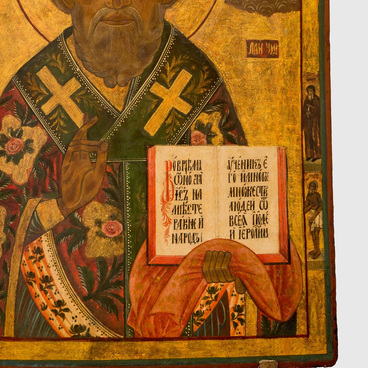In her youth, Saint Catherine received a good education, was well-versed in sciences and languages. A hermit elder taught her the Christian faith and baptized her. After the baptism, Christ appeared to Catherine and put a ring on her finger, saying: “Do not know an earthly groom.”
After that, Emperor Maximian arrived in Alexandria. At a festival in honor of pagan gods, Catherine urged the ruler to reject paganism and accept the true God, for which she was imprisoned. The emperor ordered the learned priests to convince Catherine of the rightness of the pagan faith, but in their conversations, she convinced them of the opposite. Maximian promised the girl expensive gifts and honors, but she refused them.
Maximian ordered Catherine to be tortured on a spiked breaking wheel, but she remained unharmed. He tried to win her over and turn into a pagan by promising to marry her, but she refused. Then, he ordered her head to be cut off.
The relics of St. Catherine were discovered in the 6th century on Mount Sinai by the monks of the Sinai Monastery, which then was named in her honor.
The icon “The Holy Great Martyr Catherine” is an example of a naïve folk icon. The term “naïve” does not imply that it was executed by non-professional artists. On the contrary, these people were masters of their craft. They were professionals, and earned their living by painting icons. They were experts in the special direction of the Russian icon-painting tradition developed by them, which was in keeping with the tastes and financial abilities of the largest stratum of society — peasants and artisans.
Such masters used special techniques characteristic of “naïve” icon painting, creating laconic and at the same time expressive works. The displayed icon belongs to the so-called krasnushki, or red icons (from the Russian “krasny” — “red, beautiful”). The fields of the icon are made in red, and the background is a dark shade of red. The figure of the saint and the halo are outlined with a contrasting white.
The face and open parts of the hands are also
painted in a manner that simplifies the Old Russian technique: a layer of
slightly darkened grayish whitewash is applied to the almost black base color —
sankir. The features of the face are formed by strips of sankir that are not
covered with white. The face is in the form of an elongated oval, rather heavy,
resembling a mask with schematically drawn features. The hair is painted with
the thinnest white lines over a contrasting black base. The edges of the robes
are trimmed with white linear ornament; the belt is also decorated.


